Two
ALKI AND HARBOR AVENUE
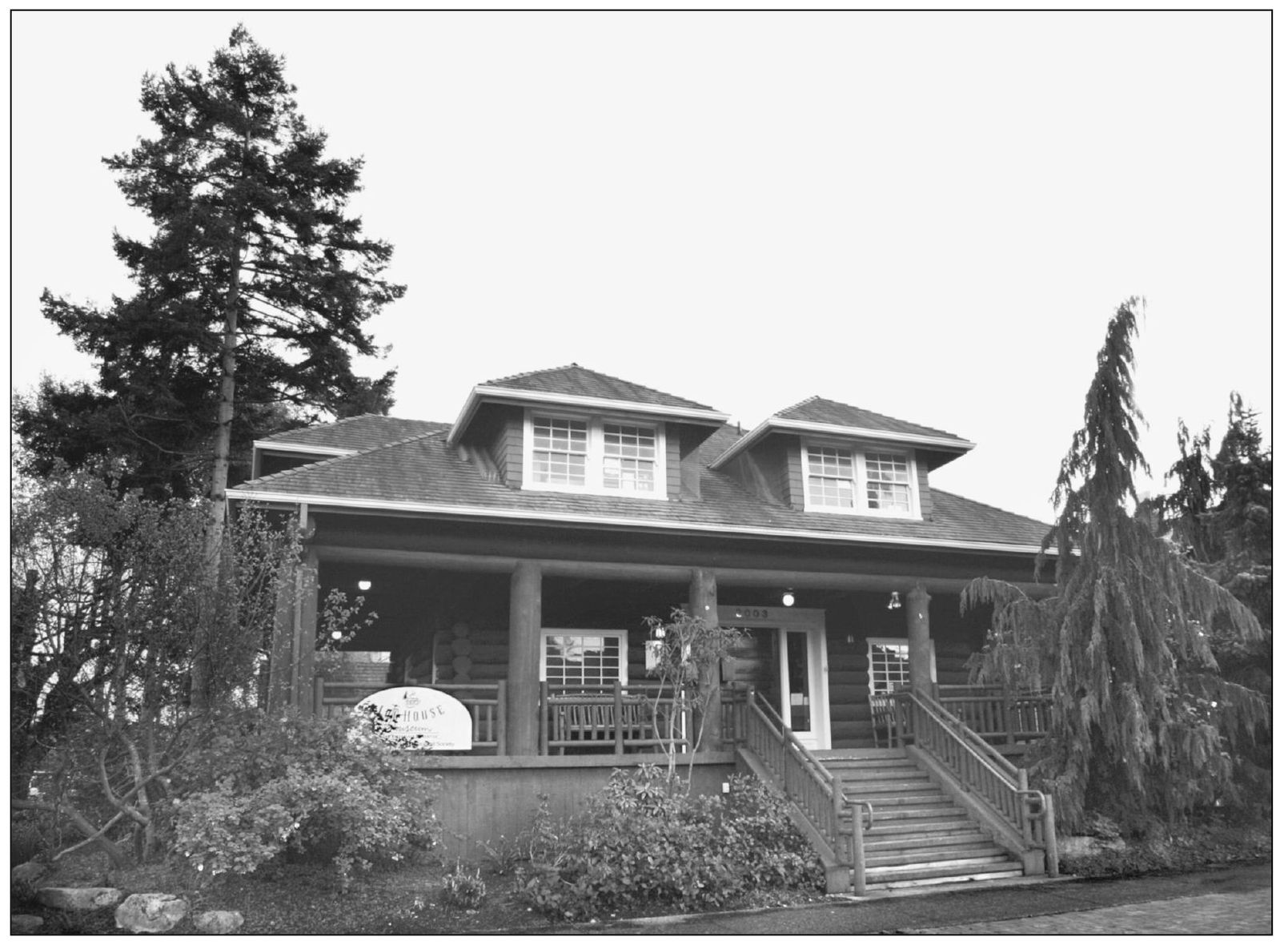
The history of the Duwamish River stretches from longhouse to log house. In 1997, the Southwest Seattle Historical Society restored and opened the Fir Lodge carriage house as a public museum called the Log House Museum. This log structure was built during the 1903–1904 winter as part of the estate of Seattle’s Bernard family, and it later became a private residence. In 2009, the Duwamish Longhouse and Cultural Center opened in West Seattle near Kellogg Island. It houses the Duwamish tribal offices, public meeting space, and exhibits.

The Williamson, Phillips, and Plummer sawmill, southeast of Duwamish Head, was built in 1864 along what is now Harbor Avenue SW. It was one of the largest mills in the northwest. The surrounding community was named Freeport and by 1877, Milton. When the West Seattle Land and Improvement Company applied for incorporation in 1888, the east side of Duwamish Head was renamed West Seattle. (Courtesy Puget Sound Maritime Historical Society.)

Arthur Stretch and William J. Hainsworth II opened the Coney Island Baths in 1899, west of Duwamish Head. An advertisement for the baths highlighted “running fresh water” for washing off sand and saltwater and “special care of private suits” as a convenience for those who spent their summers at Alki Beach in tents or cabins.

In 1908, ferry passengers visiting the Harbor Avenue business district from Seattle could ride the streetcar or walk to Luna Park and Alki beach. The tower on the right belonged to the first Seattle Yacht Club, just east of Luna Park.

This winter scene shows homes and the West Seattle business district along the east side of the peninsula viewed from Elliott Bay around 1910. The large, two-story building at center is the West Seattle Land and Improvement Company office, which sold lots in the Admiral District. The West Seattle ferry dock is just right of center.

West Seattle’s famous nightspot, The Embers, 1317 Harbor Avenue SW, is shown in the 1980s. The building dates to 1907 when it was constructed as the Dakoglou block in the Railroad Avenue business district. The Embers opened in 1964 as a jazz club. It hosted many famous bands and personalities including the Kingsmen Jr. Cadillac, Quincy Jones, Dyan Cannon, Robert Culp, and Bill Cosby. It closed in the 1980s and was demolished in 2003.

The Heffernan Dry Dock Company was located on Railroad Avenue (now Harbor Avenue SW) around 1918. The large white building was the machine shop, which became Haury’s Marina and later Seacrest Marina. Located in the building cluster to the left was an early home of the Seattle Yacht Club. The Novelty Flour Mill on the right stood as a visible landmark from 1893 to 1956 next to Harbor Island in the center.

The steamship Princess Elaine is moored on Harbor Avenue SW next to the Beach Broiler restaurant around 1960. The retired Canadian Pacific liner was conceived as a floating restaurant, but it never succeeded, and the vessel was scrapped in the early 1970s. The Beach Broiler was sold in 1985 and is now Salty’s on Alki.

Seacrest Marina was demolished in February 1984. This structure housed both the successful Heffernan Dry Dock Company in 1907 and later the popular boat rental facility Haury’s Boathouse. Located at 1660 Harbor Avenue SW, Seacrest Marina was home to the West Seattle Yacht Club, chartered in 1963. The area is now Seacrest Marina Park with boat launch facilities but no permanent moorage.

A proud young fisherman and his catch pose in front of a West Seattle boathouse rental boat on Harbor Avenue SW in the 1940s. Other West Seattle boathouses along Harbor Avenue SW providing boat rentals included Haury’s, Lloyd’s, Ernie’s, Healy’s, and Scotty’s.

Around 1910, the King and Winge Shipyard was located directly southeast of the Luna Park Amusement Park at Duwamish Head. In 1899, Albert Winge, an immigrant from Norway, and Thomas King, a Boston-trained shipbuilder, founded one of the most successful shipyards in Seattle. Pictured behind the King and Winge sign is the tower for the original Seattle Yacht Club.

The second Seattle Yacht Club anchorage around 1892 was located southeast of Duwamish Head. Originally founded in 1892, the club merged with the Elliott Bay Yacht Club in 1909, and a new clubhouse was built along Railroad Avenue (now Harbor Avenue SW). In 1918, the clubhouse was taken over by the U.S. Shipping Board for officers’ training. The club was without a facility until they moved to Portage Bay in 1920.

The Anchor Park viewpoint at Duwamish Head in 2007 provided spectacular views across Elliott Bay to Seattle. Anchor Park visitors could see remains of Luna Park’s (1907–1913) pilings exposed at low tide and a memorial to the 1906 steamship Dix, the worst maritime disaster on Puget Sound. Anchor Park was built in the early 1950s over the filled-in concrete ruins of the Luna Park swimming pools. In 2005, the former swimming pools were replaced with a pier.

Charles I. D. Looff opened the Luna Park amusement park at Duwamish Head in 1907. The park, popular in the summer months, was short lived and closed in 1913. The Alaska Pacific Yukon Exposition kept it busy in 1909, but visitation dropped off during the colder months in Seattle. Having the “longest bar on the bay” did not enhance its reputation with the local residential community. After closing, the rides went to Playland-at-the-Beach near San Francisco, California. In 1998, the carousel was purchased and restored by the City of San Francisco and moved to Yerba Buena Gardens.


When the amusement park opened in 1907, this pool was known as the Luna Park Natatorium. Renamed “Luna Pool” after the rides closed, it continued to operate until burning down in 1931. An ad in the Southland News in 1916 announced “Outdoor Sport Inside, Heated Seawater, Separate Tanks for Ladies and Children, Water Changed Daily.”
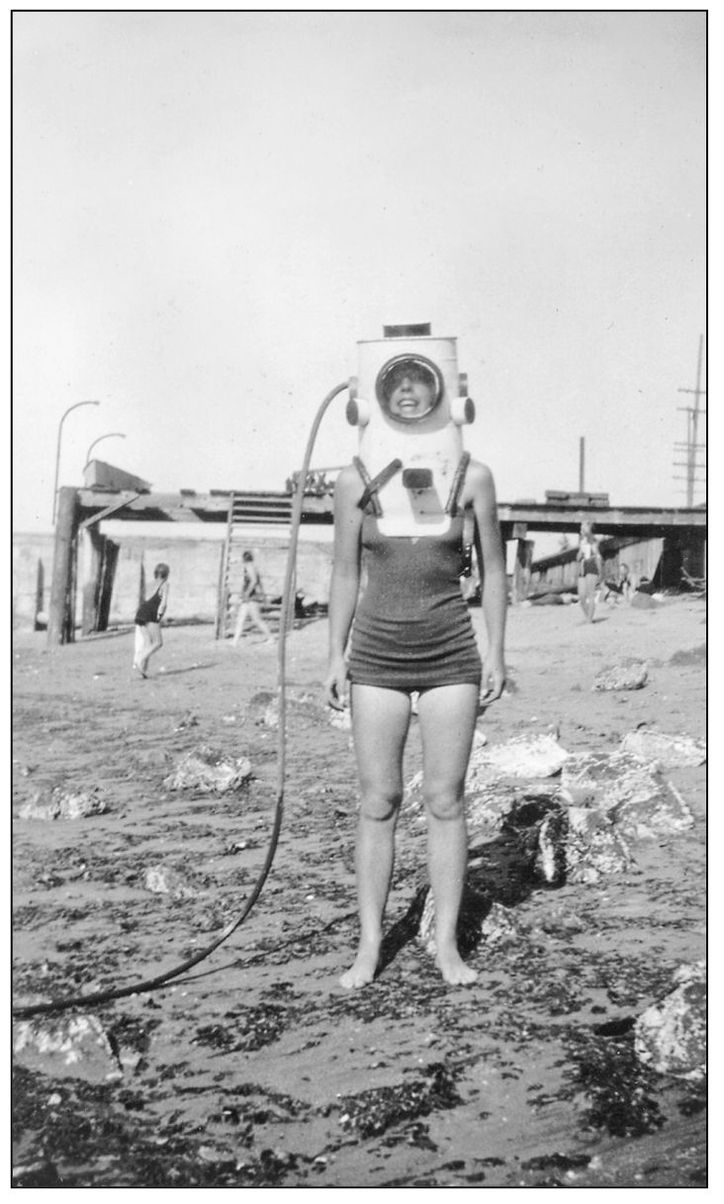
In 1933, Bernice Petty was growing up on Alki. Standing in front of the remains of Luna Pool, in a homemade diving helmet, Petty recalled when she and a friend dove off the seawall of former Luna Park. The helmet was built out of an old hot water heater.

Workers are shown building a seawall and filling in the shoreline north of California Place along Alki Avenue SW in September 1915. The fill behind the seawall established the present-day shoreline. Oceanic threats of wood-eating teredos, undertow, and tidal erosion forced repairs on this work as early as 1921. Luna Park buildings are visible in the background on the right.

The landslide damage in this photograph occurred on Alki Avenue SW in February 1951. Landslides were common along the unstable hills and bluffs of the Duwamish Peninsula. Underground springs and heavy rainfall exacerbated the instability, and some early-day residents dug tunnels into the bluffs to create needed drainage.

Wilhelmina Ringens is shown in her front garden around 1920. Ringens moved from Seattle proper to Alki Beach sometime after 1901. She lived in one of the many small beach houses, of typical construction of that period, which originally lined Alki Avenue.

Alki resident Bernice Petty plays on the homemade log teeter-totter around 1921. The photograph was taken in front of her grandmother Wilhelmina Ringens’s beach house. (See photograph above.)

This photograph shows the Alki Beach Bathing Pavilion entrance on Alki Avenue SW around 1911. Three finely dressed young women stand on the street side of the pavilion. In 1910, the city paid $75,000 for 2,500 feet of waterfront between present-day Fifty-seventh Avenue SW and Sixty-fifth Avenue SW on which the bathing pavilion was built. It opened on July 4, 1911.

The Alki Beach Bathing Pavilion was located on Alki Beach. The pavilion was also known as the “Fieldhouse.” The facility served the area as a community center, providing sources of entertainment and a home for community activities that included dances, Boy Scout events, sports such as volleyball and basketball, and Halloween haunted houses. The Fieldhouse rented swimsuits to adults for 10¢ and provided them free for children.
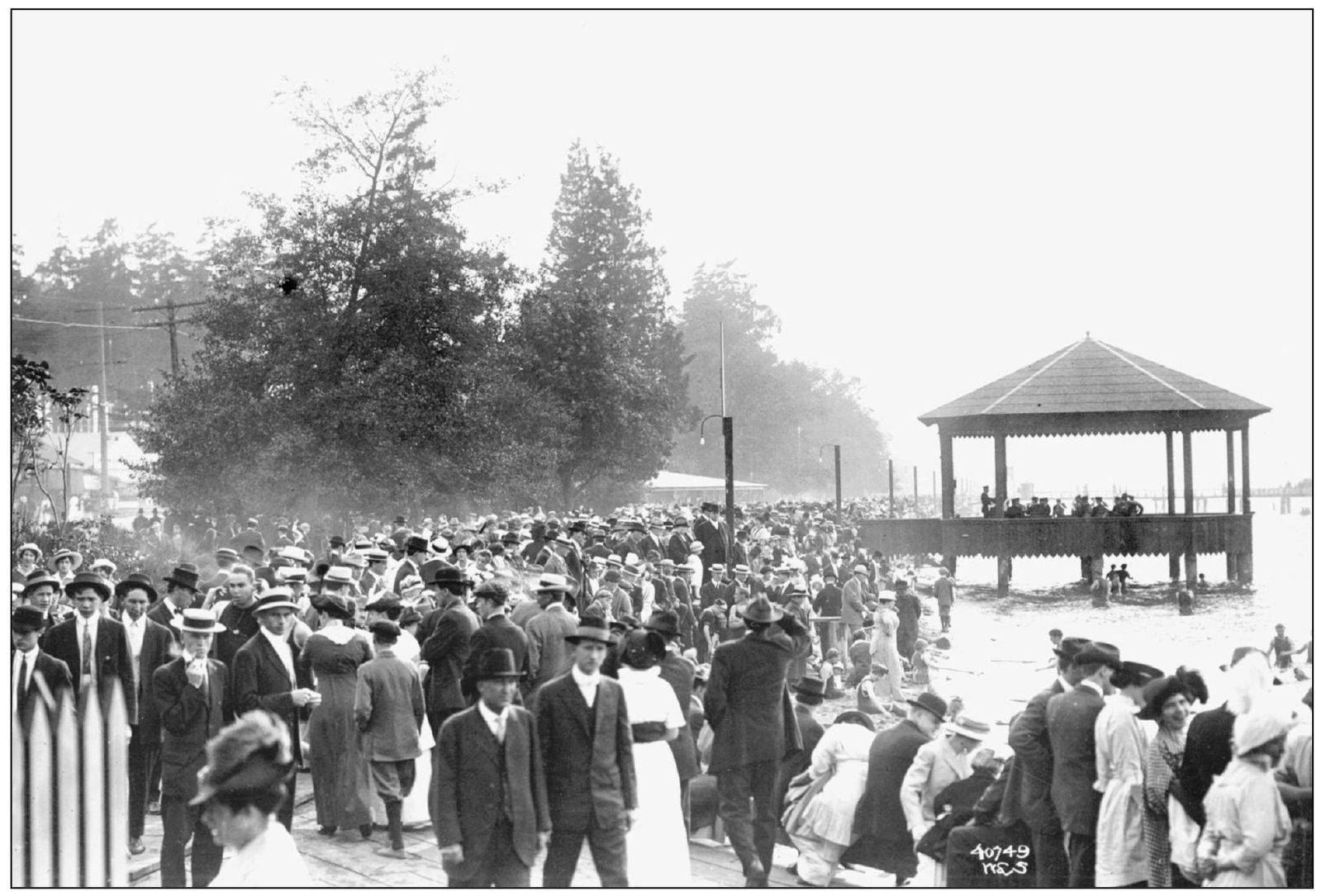
Crowds throng the Alki Beach Park promenade just southwest of the bathing pavilion. The bandstand over the water was completed in 1912, a year after the pavilion opened. More than 103,000 people attended the 75 concerts performed that year. Beachgoers arrived from Seattle by ferry and streetcar. The Alki Mosquito Fleet ferry pier is in the background.

This section of the Alki Beach promenade and seawall looks much the same today as it did when this picture was taken in the early 1940s. The Alki Natatorium is visible in the far background. The seawall was poured in curved sections in 1925 by the Seattle Engineering Department to stabilize the bank and deflect the force of wave action.

A group of men stand outside the Seaside Pharmacy located at the southeast corner of Sixty-first Avenue SW and Alki Avenue SW around 1910. The business later moved across the street, and Charles A. Richey—nicknamed the “Mayor of Alki”—purchased it in 1922. Richey’s Seaside Pharmacy was a beloved local hangout. Today the Alki Bakery occupies the building.

Around 1920, King Neptune and mermaids pose aboard the Alki parade float, an elaborately disguised Auburn touring car. West Seattle has participated in many local parades, such as the original Potlatch Parade in downtown Seattle and the later Seafair parades.

The Fir Lodge, 2717 Sixty-first Avenue SW around 1905, was one of the earliest year-round residences built in the Alki Beach area. In 1950, it became the Alki Homestead restaurant. Doris P. Nelson and her family owned the restaurant for 44 years until her death in 2004. Designated a unique Seattle landmark in 1995, it sustained fire damage in January 2009 and awaits restoration.

A group of ladies enjoys an Alki adventure aboard a West Seattle Transfer Company omnibus shown in front of the Fir Lodge around 1905. Before streetcar service began in 1907, visitors to West Seattle traveled by ferry or mosquito fleet vessels and walked or rode around the point. Horse-drawn carriages transported visitors from the docks to their destinations.

A group gathers driftwood on Alki Beach around 1909. This image is from a postcard sent to a Mrs. C. C. Lewis. The sender identifies the two men wielding the saw as Cal Meeker and Will Gary. The picture shows several docks that once existed along the beach. The King and Winge Dock, with its fish-packing plant, opened in 1905 and is visible in the far background.
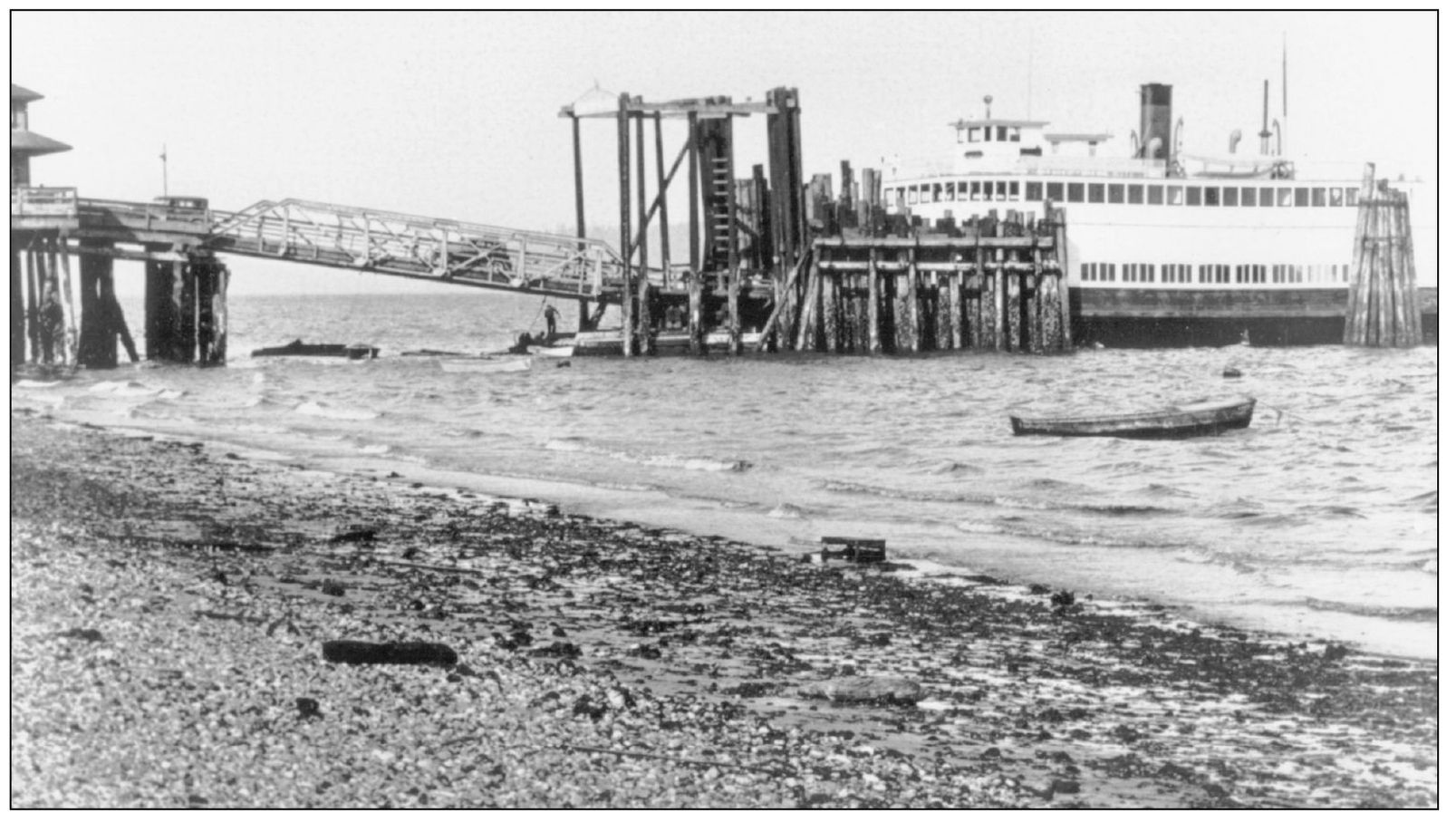
The ferry Crosline, around 1930, ran between Alki Point (just south of the lighthouse) and Manchester on the Kitsap Peninsula. The Crosline was 142 feet long and could accommodate 65 cars. It was built by the Marine Construction Company on the Duwamish River. The Alki-Manchester route ran from 1925 until 1936 when a storm washed out the Alki Point dock.
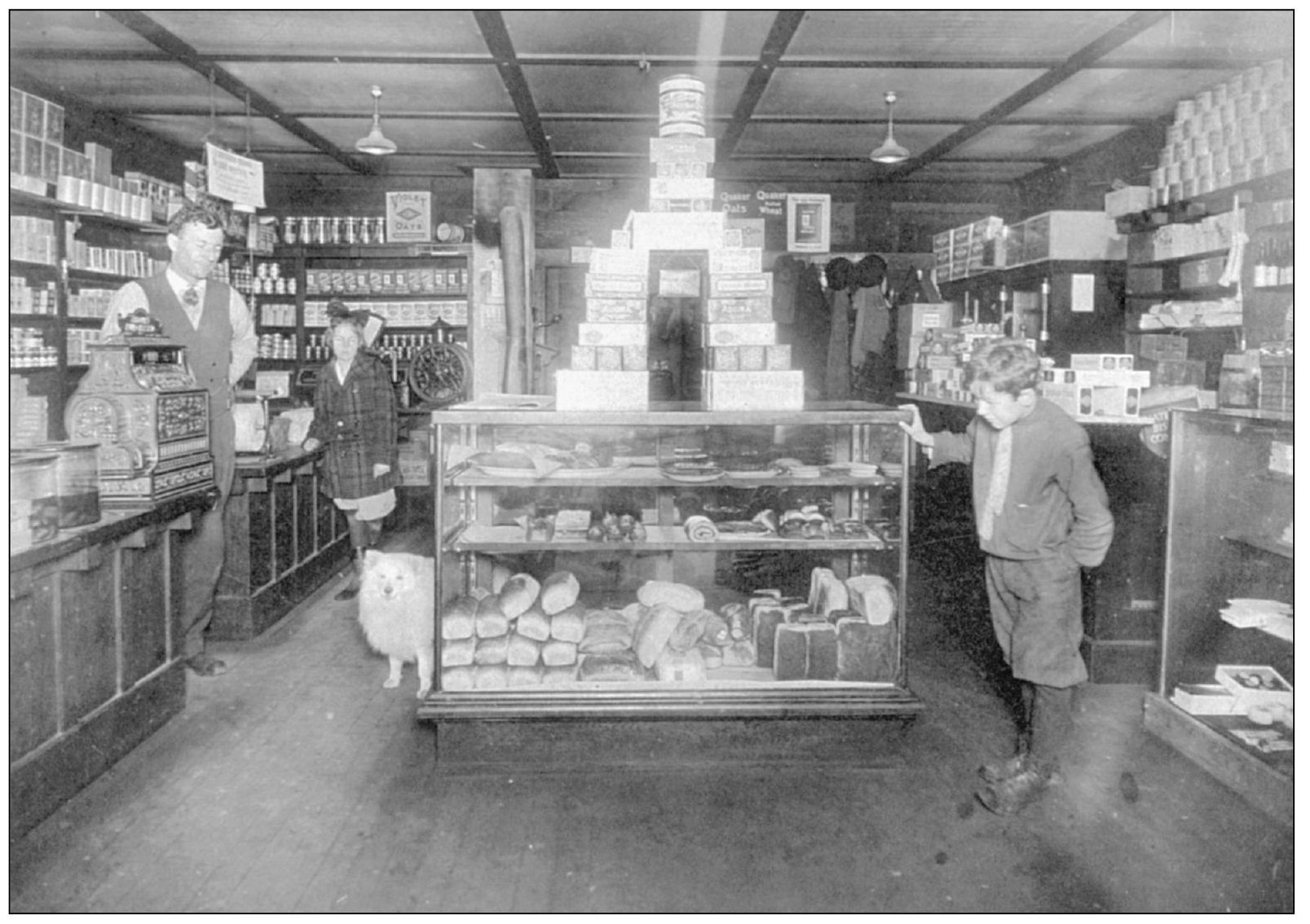
The Bonair Grocery store, around 1917, was just north of the current Alki Beach business district on Alki Avenue SW at Bonair Drive SW. It was typical of the small family-owned groceries that were in business throughout the city neighborhoods. The owners were Martin and Mattie Sherman. Their son Arthur is at the right.

Klint’s Alki RentaBike, shown here around 1940, started as a bicycle repair and rental shop in the garage behind Chas Klint’s house on Alki Avenue SW in 1937. As bike riding has always been popular along the beach, he had more than 40 bikes that he rented for 10¢ an hour. The operation, renamed Alki Beach Cycle, moved to the corner of Alki Avenue SW and Fifty-ninth Avenue SW in 1943.

Zoe Richey poses on the Alki Beach seawall in front of the shell of the Alki Natatorium. Just north of the Alki Beach Bathing Pavilion, also visible and built by a private developer, is the natatorium that opened in 1934. Five years later it went bankrupt and closed. In June 1941, the city claimed the property and renovated the neglected structure, reopening it in 1942.


The Alki Natatorium and the Alki Beach Bathing Pavilion are on the left-side shoreline in this panoramic aerial view of Alki Point around 1940. To the right of those buildings is Alki Elementary School. Farther down the shoreline is the Stockade Hotel site. The hotel was demolished in 1936. The large stand of trees in the center is Schmitz Park and at the point is the Alki Point Lighthouse.

Mrs. Klint and Mrs. Peterson pose in front of their Alki White Cap Ice Cream and Hotdog stand at Alki Avenue SW and Fifty-ninth Avenue SW. The Klints and Petersons went into business together during World War II in this structure made out of a wooden water tank. The Klints sold their interest in 1948. Hit by a city bus in 1949, the stand collapsed from the impact.

Automobiles are parked in front of Spud Fish and Chips restaurant at 2666 Alki Avenue SW around 1940. Brothers Jack and Frank Alger opened Spud Fish and Chips around 1935 in a converted garage off Alki Avenue SW. They initially served fish and chips for 10¢. When cooking grease was rationed during World War II, customers donated their ration coupons so Spud could stay in business.

This is the Birthplace of Seattle monument in front of the Stockade Hotel on Alki Avenue SW around 1910. It commemorates the settlers landing on Alki Beach in 1851. It was dedicated on November 13, 1905, by Arthur Denny’s daughter Lenora and was moved to the beach side of Alki Avenue SW in 1926. Plaques recognizing the Duwamish Tribe and the women of the Alki landing party were added to the monument in 2001.

Gen. Douglas MacArthur lays a wreath at the Birthplace of Seattle monument on Alki Avenue SW on November 13, 1951. General MacArthur took part in the founding ceremony during Seattle’s centennial celebration. He was in Seattle for a political speech at the University of Washington. Ninety-one-year-old Seattle pioneer John Adams presented the wreath to the general.

On November 13, 1951, a reenactment of the landing of the first settlers at Alki celebrated the centennial of their arrival (shown above). In 1851, a group of 10 adults and 12 children, comprised of the Denny, Bell, Boren, and Low families, and Charles Terry, arrived on a rainy day after a nine-day trip from Portland on the schooner Exact. They were met by Duwamish tribal members. The sesquicentennial celebration (2001) organized by the Southwest Seattle Historical Society is shown below. Descendents of the settlers and Duwamish tribal members were present at both reenactments.
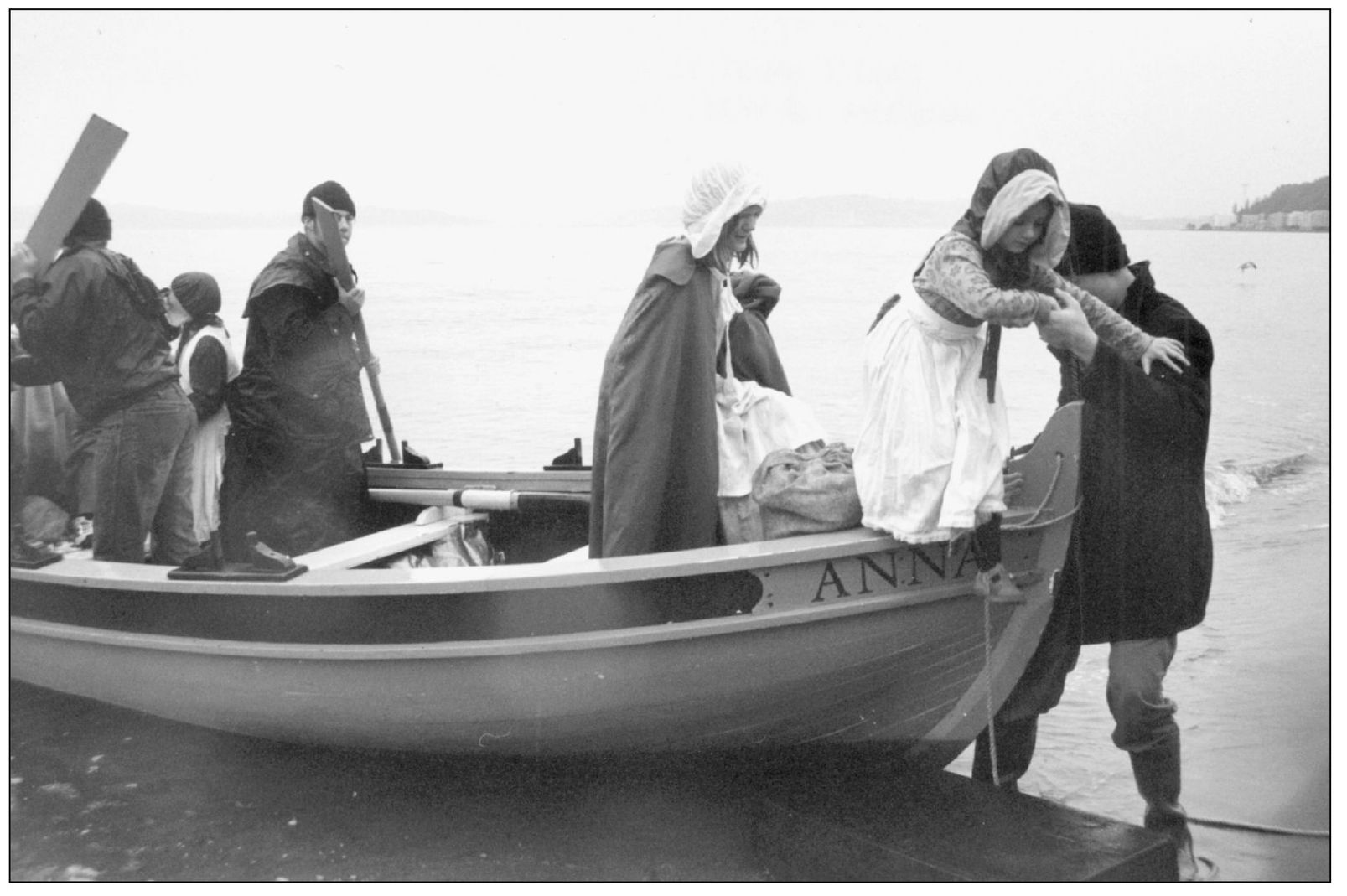

The Alki Point Lighthouse is pictured shortly after its completion in 1913 (just before it was painted). Alki Point marks the southern entrance to Elliott Bay. In 1868, Hans Martin Hanson, who owned 320 acres on the point, placed a private light there to aid local navigation. The Lighthouse Service officially established an oil post lantern at the point in 1887 and paid Hanson $15 a month to keep it. In 1910, the U.S government bought a 1.5-acre parcel from the Hanson family for a permanent light. The lighthouse was equipped with a Fresnel lens and a three-directional foghorn. It became fully automated in 1984. (Courtesy Coast Guard Museum Northwest.)

Mary Rice’s third and fourth grade class is shown around 1909 at the South Alki School, also known as the “Carroll Street School.” Attentive students sit with their books open in their classroom at this school established for younger children near Alki Point.

The Cobblestone House was located at the north end of Beach Drive SW. This unique beach home was written up in Ripley’s Believe It or Not! in the 1930s as “the smallest, complete modern house in the United States.” The house boasted an elevator that led to a large basement.

Around 1905, Rose Lodge at Alki Point, off Beach Drive SW, was a resort with excellent beach access that catered to summer visitors. It had about 50 tent cabins and a dining hall in addition to the main lodge. The tents were replaced with actual cabins in the 1920s. The lodge building still exists.
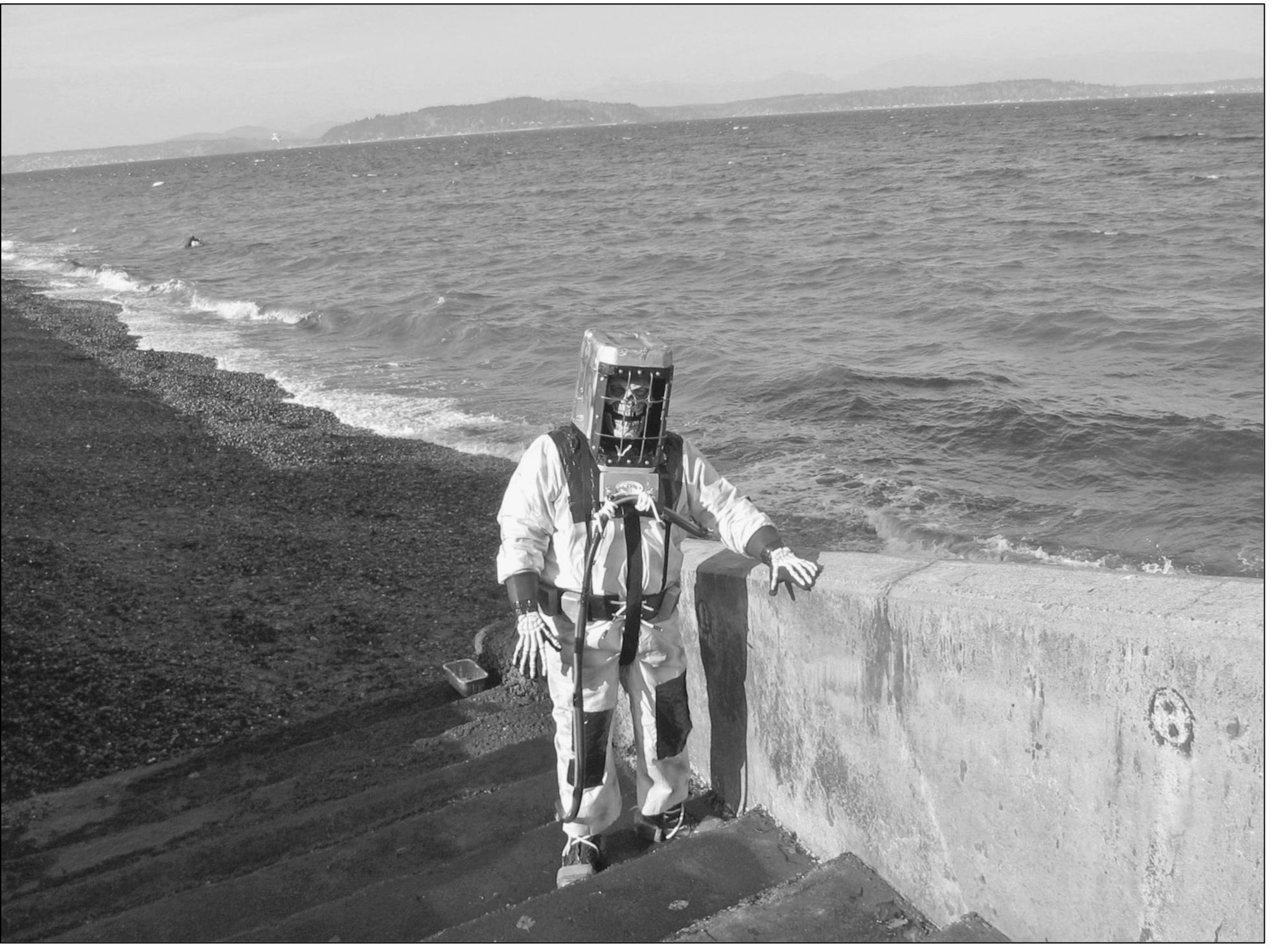
Capturing the Alki Beach experience is always an adventure. There is no telling what can come up from the depths of Puget Sound. (Courtesy Don Kelstrom.)